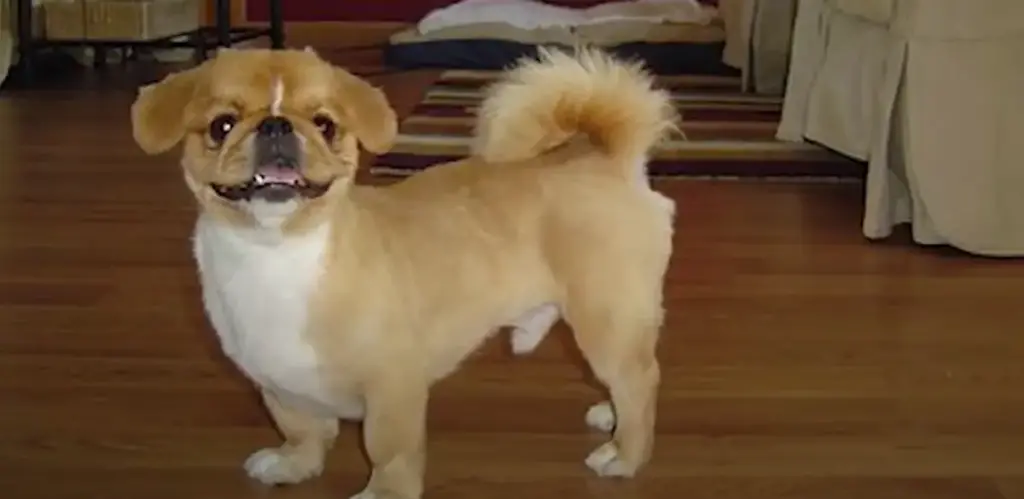Imagine a companion whose expressive eyes reflect a blend of ancient Chinese heritage and regal charm—a small, yet sturdy figure strolling across the room with a gait that commands gentle attention.
You’ve just pictured the Puginese, a crossbreed that marries the spirited vivacity of a Pug with the dignified composure of a Pekingese.
As you contemplate adding a furry member to your household, it’s crucial to understand the mosaic of traits that a Puginese brings to the table. Their temperament often strikes a balance between affectionate loyalty and an independent streak, which can be as endearing as it is challenging.
While their social tendencies and suitability for apartment life might seem like an ideal match, the nuances of their care, including health considerations inherent to their distinctive physical structure, demand a closer look.
Will the Puginese’s unique characteristics seamlessly weave into the tapestry of your daily life? Only a deeper exploration of their world will reveal whether this delightful mix is the perfect addition to your home.
- Noise Level
- Energy
- Sociability
- Trainability
- Care
- Health
Overall
Summary
Puginese are moderately noisy dogs with a medium to high energy level. They are sociable and relatively easy to care for, though their trainability may require some patience. Generally, they enjoy good health with proper care.
Puginese: Traits, Temperament, and Care Guide
The Puginese, a hybrid of the Pekingese and Pug breeds, exhibits traits such as a loving disposition and a distinctive appearance that necessitates a tailored approach to their care and upbringing.
They’re well-suited for apartment living as a compact hybrid breed due to their small size and moderate energy levels. Analyzing their temperament reveals an affectionate nature, yet they may exhibit caution around strangers, highlighting the importance of early and consistent socialization.
Careful attention is vital in maintaining their well-being, particularly as they may vie to be the sole canine companion. Their parent breeds contribute to unique care requirements, including regular grooming and health monitoring.
Patience is key in training, as their eagerness to please is sometimes offset by a stubborn streak.
Exploring the Characteristics of the Puginese
Delving into the Puginese’s characteristics reveals a unique combination of physical and behavioral traits inherited from their Pekingese and Pug lineage. This designer hybrid embodies the essence of small-breed dogs, aiming to please and suitable for apartment living. However, their short muzzles may lead to low energy levels and potential health concerns, impacting their lifespan. Each Puginese is distinctive, with sociability ranging from reserved to affectionate, especially towards their owners.
| Trait | Description |
|---|---|
| Energy Level | Lower energy, suitable for short walks, may have breathing difficulties |
| Sociability | Varies, typically affectionate with owners, better with smaller pets |
| Health Concerns | Prone to allergies, diabetes, and heart issues, due to the short muzzle |
| Lifespan | Approximately 12-14 years, with proper care and attention |
Analyzing these aspects is crucial for prospective owners to gauge if a Puginese would seamlessly integrate into their lives, particularly in quieter households.
Puginese: A Comprehensive Profile and Guide
You’ll find that the Puginese blend distinct physical characteristics and behavioral traits from their Pekingese and Pug lineage.
As you consider this breed for your household, it’s essential to understand their specific needs, from exercise limitations to potential health concerns.
This profile will equip you with the critical information required to ensure a Puginese thrives under your care.
Everything You Need to Know
Understanding the Puginese’s genetic background is crucial for appreciating their unique respiratory needs, life expectancy, and social tendencies stem from blending Pekingese and Pug lineages. As a designer breed, the Puginese inherits traits from the Pekingese and the Pug, creating a distinct temperament in this hybrid. Here’s a detailed snapshot:
- Health & Maintenance
- Prone to brachycephalic syndrome; watch for respiratory difficulties.
- Requires a moderate amount of grooming to maintain coat health.
- Social & Lifespan Characteristics
- Lifespan typically ranges from 12-14 years.
- May exhibit variable sociability; often affectionate and loyal to owners.
Belonging to a community like the American Canine Hybrid Club, the Puginese mix is a testament to the enduring appeal of crossbreed companionship.

Discovering the Temperament
Exploring the Puginese temperament reveals a breed that typically exhibits a sweet disposition, yet requires early socialization to develop tolerance towards unfamiliar faces. This designer breed, a blend of its Pug parent and Pekingese dogs, can show a penchant for stubborn behavior.
It’s crucial to employ patience and positive reinforcement during training, as they’re keen to please but may resist overbearing methods. They’re well suited for apartment living, thanks to their low energy levels, making them a wonderful companion for those seeking a serene pet.
While they thrive in quiet households, preferably with older individuals, their moderate tolerance suggests they may not be ideal for homes with young, active children or boisterous pets. Integration into a family unit where they feel they belong is paramount for their well-being.
Puginese: Is It a Good Fit for Families?
When considering if a Puginese is the right addition to your family, you must evaluate the breed’s preference for tranquility against your household’s energy levels.
They’re a match for families with older children who respect a dog’s need for a peaceful environment.
Your decision-making process should also consider a puginese’s need for moderate socialization and potential as a sole pet.
Assessing Puginese’s Compatibility with Families and Kids
Considering the unique needs of a Puginese, families with older children or those seeking a lower-energy pet may find this breed an ideal companion. Analyzing the Puginese’s temperament reveals that while they’re gentle and affectionate, their small breed characteristics often make them more suitable for a quieter family dynamic.
Let’s delve deeper:
- Family-Friendly Qualities
- Affectionate and enjoys the company of older children who are more patient
- Calm disposition aligns with families seeking a less active pet
- Considerations for Families with Kids
- Requires socialization to be comfortable around children and visitors
- Energetic kids may overwhelm the Puginese’s preference for peacefulness
Puginese Adaptation Skills
The Puginese, a crossbreed known for its adaptability, thrives in apartment settings and requires minimal exercise, making it an ideal companion for urban dwellers. As a small designer breed, the Puginese inherits adaptation skills from both the Pug and Pekingese, allowing it to comfortably adjust to living in a house with limited space. This breed’s moderate energy aligns well with a less active lifestyle.
However, regular socialization is necessary to maintain their mental well-being. The Puginese are quite alert, benefiting from early exposure to different scenarios to cultivate a well-rounded temperament. They’re equipped to handle various indoor environments, provided they’re not exposed to extreme temperatures.
Keep in mind, while they adapt well indoors, they do require consistent grooming to support their skin and coat health.
Puginese Training Essentials
When training your Puginese, applying consistent and positive reinforcement techniques is essential, as their stubbornness can otherwise hinder progress.
It would be best to prioritize early socialization to foster their tolerance towards new faces and fellow pets.
Effective Training Strategies
To effectively train a Puginese, you must employ consistent and patient strategies, capitalizing on their desire to please with positive reinforcement and rewards. Remember, Pugineses are sometimes stubborn, so being persistent and clear about expectations is crucial. Proper socialization is key; expose them to various scenarios early to develop their adaptability.
| Strategy | Benefit |
|---|---|
| Positive Techniques | Fosters a willing to please attitude |
| Short, Focused Sessions | Complements low energy levels |
| Proper Socialization | Enhances tolerance to stimuli |
| Daily Walks and Obedience Training | Establishes leadership and control |
When it comes to training your Puginese, they’ll love spending time with you, and these effective training strategies will ensure you both enjoy the process.

Exercise and Grooming Needs
Despite their low energy levels, Puginese dogs still require regular short walks or backyard playtime to maintain optimal health. As a little dog with a not-so-active breed disposition, a daily walk satisfies their exercise needs. However, be mindful of their sensitivity to extreme temperatures.
Your Puginese’s long hair demands considerable grooming, at least twice a week, to prevent matting and maintain skin health. Pay special attention to their facial folds to avert potential eye problems.
A balanced diet, preferably with high-quality dry dog food, is crucial to prevent obesity, a common concern in these dogs. Regular vet visits are essential to monitor for signs of diabetes and allergies, ensuring your Puginese leads a happy and healthy life.
Health Considerations
When considering a Puginese, it’s crucial to understand their predisposition to specific health issues stemming from their Pug and Pekingese lineage. You’ll need to be vigilant about potential respiratory challenges, skin conditions, and the necessity for routine eye and dental care.
Their lifespan and overall well-being hinge on proactive monitoring for signs of heart problems, epilepsy, and allergies, alongside managing their diet to prevent obesity and diabetes.
Common Health Issues and Lifespan
Puginese dogs typically live 12 to 14 years, but health issues, such as respiratory and heart conditions, skin ailments, epilepsy, and eye problems, can affect their overall well-being.
As a proud member of the Puginese community, you’re likely aware that this designer breed—a charming mix of Pekingese and Pug—requires attentive care to mitigate these health problems.
Buying from a reputable breeder helps ensure you’re welcoming a healthier Puginese into your family. While the American Kennel Club does not recognize this dog breed, various American Canine Hybrid clubs honor it, attesting to its growing popularity.
Is Puginese the Right Dog for You?
When considering a Puginese as a pet, it’s essential to analyze whether their low-energy disposition and need for a tranquil environment align with your lifestyle. This designer breed, while among popular designer dogs, may not suit homes with young, energetic children or noisy settings.
Puginese dog breed traits indicate they often prefer being the only pet, though they can be good with other pets if introductions are handled carefully. Their temperament is sweet-tempered, requiring a lot of attention, thriving in settings where companionship is a constant.
They may bark to alert you, but won’t demand extensive outdoor activities, making them ideal if you enjoy spending time around the house. Consider these factors carefully to ensure the Puginese fits into your world.
Conclusion
In the tapestry of canine companionship, the Puginese emerges as a distinct thread, weaving affection with caution.
Your journey with this breed mirrors an alchemist’s pursuit—balancing their jovial spirit against the delicate crucible of health.
As you navigate their care, each day becomes a meticulous study, revealing the profound bond between nurture and nature.
Choose the Puginese if your life’s rhythm harmonizes with their serene and intricate symphony of traits.
